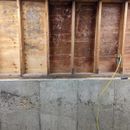Choosing Basement Wall Insulation
Hi there,
I realize that insulating and sealing is a topic that has been written about extensively – both in articles and in the Q&A. The wealth of information might be part of my problem as my head is now positively spinning with solutions, points to consider, and counter points. I also apologize in advance for the size of this question.
My situation is as follows:
I recently purchased a house in zone 5A. The house has a poured concrete foundation that is not insulated. ~75% of the foundation is below ground with one side being completely above ground. The above ground section consists of ~ 4 ft. of concrete with the remainder of the basement wall being a 2×6 stud wall. The stud wall was covered in drywall and, as I recently learned, insulated with unfaced fiberglass insulation with no vapor retarder. The house is wrapped with Tyvek and has vinyl siding.
While doing some work on this stud wall, I found that there was mold forming on the sheathing where the insulation touched. A similar issue presented itself in the rim joist, which was also insulated with unfaced fiberglass.
After reading through everything I can find, I believe I have arrived at a solution that would meet my goals of preventing a recurrence of the mold while also improving the overall insulation of the basement. I’m not looking for perfection, but a stop to the moisture issue and an improvement to the insulation of this wall.
My plan is as follows:
*Rim joists: fill with closed cell spray foam as I have some tight spaced with nearby joists. (see https://www.greenbuildingadvisor.com/article/insulating-rim-joists)
*Stud Wall: this is where I struggle the most. I have flopped continuously between rigid foam, open cell, and closed cell foam. Since it is a fairly small wall, cost for this portion isn’t a major motivator and I’m trying to judge the solutions on technical and DIY installation merits alone. As I need an air barrier and do not have exterior rigid foam, my understanding is that OC spray foam would be out of the running. This then took me to close cell, but the following article dissuaded me from closed cell: https://www.greenbuildingadvisor.com/article/installing-closed-cell-spray-foam-between-studs-is-a-waste
This leaves me with using poly rigid foam while sealing around the edges with big gap spray foam.
Is this really an appropriate/good approach? Will thermal bridging be eliminating a large amount of my insulating capacity?
*Above ground concrete: follow assembly #1 (foam board to required R mounted directly to concrete with 1×4 strapping to attach thermal block) found in https://www.greenbuildingadvisor.com/article/three-ways-to-insulate-a-basement-wall
Finally, I’ve been questioning whether insulating the concrete is worth it at all, since I will not immediately be insulating the rest of the basement (multiple oil tanks, built-in workbenches, etc. abound and block access to the other three walls). That being the case, would insulating the one above ground wall provide actually provide any benefit?
Thank you all for your time and apologies again for the size of this!
Brian
GBA Detail Library
A collection of one thousand construction details organized by climate and house part










Replies
Deleted
I would rip some shims to get the stud wall in plane with the concrete bellow. Insulate the stud wall with unfaced batts.
Cover the whole thing, foundation and stud wall with the required rigid insulation in your area to pass code (R10 to R15) with the seams taped. Strap the whole thing out with 1x3 and hang drywall. The rigid will act as a vapor barrier for the stud wall.
The rim joist area is best insulated with SPF.
This is extremely helpful Akos. Thank you! It wouldn't have occurred to me to bring it all flush, which seems much more simple and will have better seals.
My understanding is that it's best to avoid XPS and also leave a gap or use sill seal between the foam and the floor of the foundation.
Thank you again!